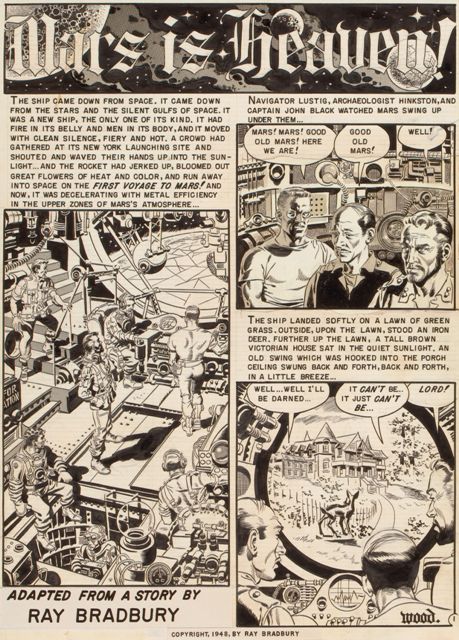(1) READ THE GAME. The Read it Forward site is celebrating Ready Player One’s theatrical debut this week with an interactive 8-bit-inspired excerpt that “gamifies” the prologue from Ernest Cline’s novel. [Click on the GIF to view.]
Read your way to the top of the Scoreboard as you earn points for discovering Easter eggs that bring the content to life. As readers learn of Parzival’s hunt for the keys to OASIS, they’ll maneuver their way around a maze, attend an ‘80s dance party, unlock footnotes, and more. Upon completion, readers can add their name to a Scoreboard and share their score with a link to the excerpt on social media. All of the excerpt’s hidden extras are unlocked once a reader earns the maximum score of 10,000 points.
(2) TV INTEREST IN THREE-BODY PROBLEM. From io9: “Report: Amazon May Pay $1 Billion to Adapt the Hugo-Winning Chinese Novel The Three-Body Problem”.
The Hugo-winning Chinese novel The Three-Body Problem could become Amazon’s Game of Thrones. A new report from Financial Times suggests Amazon is pursuing a deal to make a three-season television show based on the trilogy from Liu Cixin, and it may be willing to pay up to $1 billion to do so.
According to the Financial Times report, international investors say Amazon is negotiating for the rights to produce three seasons based on Remembrance of Earth’s Past, the scifi trilogy more commonly known by the title of its first book, The Three-Body Problem.
In a statement reported by Chinese news outlets, YooZoo Pictures stated that it remains the sole owners for the film and TV rights for The Three-Body Problem, though it didn’t comment on whether Amazon had approached the company or were in talks with them to collaborate on this reported streaming project. Cixin was also asked about this development by Chinese news outlet MTime.com, where he revealed he knew nothing about the project and doesn’t know if he’d be invited to work on it.
(3) DISSENTING VOICE. In contrast to those looking forward to the movie, Vox says “The Ready Player One book used to be considered a fun romp. Then Gamergate happened,” in “The Ready Player One backlash, explained”.
A time traveler from 2011 could be forgiven for being deeply confused by this response. In 2011, Ready Player One was beloved. It was “a guaranteed pleasure.” It was “witty.” It was not only “a simple bit of fun” but also “a rich and plausible picture of future friendships in a world not too distant from our own.”
What gives? How did the consensus on a single book go from “exuberant and meaningful fun!” to “everything that is wrong with the internet!” over the span of seven years?
… But the main thing Ready Player One is doing is telling those ’80s-boy-culture-obsessed gamers that they matter, that in fact they are the most important people in the universe. That knowing every single goddamn word of Monty Python and the Holy Grail can have life-or-death stakes, because why shouldn’t it? (Yes, that is a crucial step in Wade’s battle to save the OASIS.)
For readers in Cline’s target demographic in 2011, that message felt empowering. For readers who weren’t, it felt like a harmless piece of affirmation meant for someone else. Everyone deserves a silly escapist fantasy, right? And since Cline’s silly escapist fantasy wasn’t specifically meant for girls — unlike, say, Twilight, which was getting savaged in popular culture at the time — Ready Player One was largely left alone by the people it wasn’t built for…
(4) ASHBY STORY. This month’s entry in the Future Tense Fiction series, “Domestic Violence” by Madeline Ashby, is a free read at Slate.
A partnership of Slate, New America, and Arizona State University, Future Tense explores how emerging technologies will change the way we live. The latest consumer gadgets are intriguing, but we focus on the longer-term transformative power of robotics, information and communication technologies, synthetic biology, augmented reality, space exploration, and other technologies. Future Tense seeks to understand the latest technological and scientific breakthroughs, and what they mean for our environment, how we relate to one another, and what it means to be human. Future Tense also examines whether technology and its development can be governed democratically and ethically.
And there’s also a response essay from Ian Harris, who works on technology issues with the National Network to End Domestic Violence: “The Complicated Relationship Between Abuse and Tech”.
Violence against women is having something of a moment right now. Which is to say, portrayals of domestic violence in film and TV are gaining critical acclaim. Through shows like Big Little Lies and movies like I, Tonya, popular culture is grappling with more nuanced representations of domestic violence and the humanity of survivors of abuse. These are important conversations, and I hope that this is the start of a profound societal transformation, though time will tell. For me, the most disturbing part of these portrayals is not the brutality of the assaults, but how frequently physical violence is prioritized over other types of abusive behavior. It is what we don’t see that worries me.
We see this distorted prioritization in real life, too. I’ve been a domestic violence attorney for more than a decade. Despite the long list of clients who have struggled to get the justice system to live up to its name, I have found that survivors are much more likely to get help for physical assaults than for other kinds of abusive behavior such as stalking, surveillance, harassment, and intimate image disclosures, which frequently feel more harmful to the survivor.
(5) AVENGERS PLUG. A new TV spot for Marvel Studios’ Avengers: Infinity War.
The end is near. One month until Avengers: Infinity War.
(6) SEARCH FOR DIVERSE FICTION. Rocket Stack Rank has another new feature. Greg Hullender explains:
In response to readers who wanted a way to find good stories by diverse authors, we did an analysis of the most-recommended short speculative fiction stories written by people of color in 2015 and 2016 — “Best People of Color SF/F of 2015-2016”.
This only looks at stories that got some sort of recognition (e.g. solid recommendation from a prolific reviewer, inclusion in a years-best anthology, finalist for a major award), so just 481 stories across those two years. Of those, 112 were written by people of color.
The credit for this work goes to Eric Wong, who did the hard work of looking up information on all the authors as well as customizing the software to let readers group the data different ways.
(7) BLOWN UP, SIR. In “This teacher aims to get kids fired up about chemistry”, the Washington Post’s Kitson Jazynka profiles University of Texas chemistry instructor Kate Biberdorf, who “breathes fire and makes explosions that blast the eyes out of jack-o-lanterns.”
Or what about one who, with a quick pour of potassium iodide into a mix of hydrogen peroxide, dish soap and food coloring, makes bubbly foam that shoots toward the ceiling? Kate Biberdorf is no imaginary teacher. She’s real, and she’s coming to Washington next month, bringing along her blowtorch and cornstarch, her supplies of liquid nitrogen and dry ice, and a lot of enthusiasm for chemistry.
Bibersdorf’s website is http://katethechemist.com/. How could Filers NOT be interested in a woman who says her goal in life is “to have an explosive science show in Vegas?”
(8) HELP BILL SPENCER. Paul Di Filippo urges readers to support a GoFundMe that will “Give Back to Bill Spencer”.
We all need a little help sometimes. This is one of those times for Bill. He has several different health issues going on right now and the medical expenses he is incurring that are not covered through Medicare are mounting and could get much worse. As well, he’s facing some unforeseeable out of pocket expenses that could potentially end up being a serious problem. Right now, Bill simply doesn’t have enough for monthly bills, day to day living expenses and numerous co-pays that keep coming his way for various medical necessities.
Many readers know Bill as the award-winning writer William Browning Spencer, author of novels like Zod Wallop, Resume with Monsters and short-story collections like his latest, The Unorthodox Dr. Draper and Other Stories.
But Bill has contributed to others in a very different way as well. By freely and graciously donating endless amounts of his time over the years to sponsoring and supporting people who are facing their own daunting problems related to alcohol, drugs and living life. It’s time to give back to Bill what he has so freely given.
This is something Bill would never ask for himself, but he is one of my best friends and I know he is important to folks like yourself, who may wish to help in his time of need. Bill is truly one of the most amazing, caring and hilarious human beings I know and if you’re reading this you most likely feel the same. I think we’d all love for Bill to have the peace of mind of knowing that, whatever happens, he need not be stressed out and worried each day about how he’s going to pay for medication or a test or procedure he needs on top of his modest monthly and day to day expenses.
(9) BISCHOFF OBIT. Writer David Bischoff, 66, of Eugene, OR died March 19. He was a contributor to Doug Fratz’ 1970s fanzine Thrust. His first professional successes included The Seeker, a novel published in 1976, and the Nebula-nominated story “Tin Woodman,” co-authored with Dnnis Bailey, later adapted into both a novel and TV episode for Star Trek: The Next Generation. He also wrote the Star Trek tie-in novel Grounded, which spent time on the bestseller list. His other TV work included Dinosaucers (with Ted Pedersen). Bischoff wrote 75 original novels, and tie-in novels for movies and TV series.
(10) A POLICEMAN’S LOT. Camestros Felapton reacted to Richard Paolinelli’s minor league prank of complaining to the Aussie cops about Felapton’s blog.
A stalwart champion of free speech has attempted to report me to the federal police for the crime of having a blog – once again surpassing satire.
— Camestros Felapton (@CamestrosF) March 26, 2018
Cop’s spouse: did you catch many evil doers today honey?
Cop: Mainly read an advice column on the internet…by a dinosaur…about how t-Rexs drink too much and try to climb trees when they are drunk…
Cop’s spouse: Just another day on the mean crime ridden streets of Canberra— Camestros Felapton (@CamestrosF) March 27, 2018
(11) MOUNTAINTOP EXPERIENCE. “The hidden history of the UK’s highest peak”: A tourist hiking trail once led to an early weather station whose records are now being used to trace climate change.
Back in Victorian Britain, science was still largely an amateur pastime conducted by bands of self-financed enthusiasts who formed scientific societies. One was the Scottish Meteorological Society, which set up and maintained a network of weather stations across Scotland between 1855 and 1920.
(12) WAVE GOODBYE. “Stephen Hawking’s final interview: A beautiful Universe” starts from LIGO discovery of grav waves.
Tell us how important is the detection of two colliding neutron stars?
It is a genuine milestone. It is the first ever detection of a gravitational wave source with an electromagnetic counterpart. It confirms that short gamma-ray bursts occur with neutron star mergers. It gives a new way of determining distances in cosmology. And it teaches us about the behaviour of matter with incredibly high density.
(13) MAY THE ODDS BE ALWAYS IN YOUR FAVOR. Don’t look up — “Tiangong-1: China space station may fall to Earth ‘in days'”.
Should I be worried?
No. Most of the 8.5-tonne station will disintegrate as it passes through the atmosphere.
Some very dense parts such as the fuel tanks or rocket engines might not burn up completely. However, even if parts do survive to the Earth’s surface, the chances of them hitting a person are incredibly slim.
“Our experience is that for such large objects typically between 20% and 40% of the original mass will survive re-entry and then could be found on the ground, theoretically,” the head of Esa’s space debris office, Holger Krag, told reporters at a recent briefing.
“However, to be injured by one of these fragments is extremely unlikely. My estimate is that the probability of being injured by one of these fragments is similar to the probability of being hit by lightning twice in the same year.”
(14) WEDDING BELLS. Page Six headline: “‘Star Trek’ star marries Leonard Nimoy’s son”:
Live long and prosper, you two.
Adam Nimoy, son of the late “Star Trek” icon Leonard Nimoy, and “Star Trek: Deep Space Nine” actress Terry Farrell married on Monday, on what would’ve been Leonard Nimoy’s 87th birthday.
The couple tied the knot in a civil ceremony at City Hall in San Francisco, according to film critic Scott Mantz, who tweeted a photo of the couple on their wedding day. Farrell retweeted Mantz’s photo and wrote, “Freakin AWESOME day!!!!!!! Love ya all! Aka: Mrs. Adam Nimoy.”
She also changed her Twitter bio to include “Mrs. Adam Nimoy.”
RT BREAKING NEWS!! ADAM NIMOY & TERRY FARRELL got MARRIED TODAY at a CIVIL CEREMONY at CITY HALL in SAN FRANCISCO! Today is the BIRTHDAY of Adam’s father #LeonardNimoy! Big CONGRATS to the happy couple!! #LLAP #StarTrek pic.twitter.com/sGB8OX2Tir
— Scott Mantz ???? (@MovieMantz) March 26, 2018
(15) COMPLAINTS ABOUT DATE OF HUGO ANNOUNCEMENT. The announcement of the 2018 Hugo finalists wouldn’t be on March 31/Passover/Easter weekend/a Saturday if it was up to these folks:
https://twitter.com/leeflower/status/978651161560604672
https://twitter.com/leeflower/status/978653913250451457
Hey @Dublin2019, PLEASE, Next year, please announce the Hugo Award Finalists on a Monday or Tuesday morning, not on a Saturday.This is a tradition that long since has lost its usefulness. https://t.co/OZn8jADkDu
— Paul "Princejvstin" Weimer (@PrinceJvstin) March 27, 2018
Without fail, WorldCon always announces the Hugos on the most inconvinient day possible. It's like they don't want people paying attention.
— Aidan Moher (@adribbleofink) March 27, 2018
https://twitter.com/RoseLemberg/status/978702831598342144
https://twitter.com/RoseLemberg/status/978704226028269568
Hugo nominations have almost always been announced the day before Easter. It’s a bad day to do this for so many reasons. Last year was a rare and happy exception.
— John Chu (@john_chu) March 27, 2018
Last year was the anomaly. Releasing the info simultaneously on the weekend of multiple Easter weekend conventions has been the tradition as long as I remember. (Not saying it's good or defensible. I was just pleasantly surprised it was a weekday last year)
— Mur Lafferty (@mightymur) March 27, 2018
It was a good anomaly, and they should have stuck with it. All I'm saying is, if they can break tradition once, it's clearly not that powerful or important a tradition.
— La Rappresentante di Navah ???????? ???????????????????????? (@navahw) March 27, 2018
Part of a longstanding tradition of announcing them the weekend of Easter, so it's always been an inconvenience to observant Christians. This year, by fluke of the calendar, they're discriminating a little bit less.
— Robert Thau — @[email protected] (@rsthau) March 27, 2018
Nebula finalists are usually announced on a weekday. Makes sense for getting press.
— Sarah Pinsker (@SarahPinsker) March 27, 2018
https://twitter.com/ohseafarer/status/978732880070434817
https://twitter.com/XtinaSchelin/status/978715492759240704
https://twitter.com/dongwon/status/978734074306203648
https://twitter.com/MikeRUnderwood/status/978738342220238850
https://twitter.com/ULTRAGOTHA/status/978738180089368576
(16) VERTLIEB CANVASSES. Rondo Awards voting closes April 8 at midnight and Steve Vertlieb hopes people will consider his nominated article “Robert Bloch: The Clown at Midnight” for Best Article of the Year.
My published work about the author of “Psycho” … “Robert Bloch: The Clown At Midnight” … has been nominated for a Rondo Award for “Best Article of the Year.” Anyone can vote. This year’s competition ends Sunday night, April 8th, at midnight. To vote for my remembrance of Robert, simply send your choice, along with your name, to [email protected]
This is the story of my twenty five year friendship with acclaimed writer Robert Bloch, the author of Psycho. It is the newly published remembrance of a complex, remarkable man, and our affectionate relationship over a quarter century.
Robert Bloch was one of the founding fathers of classic horror, fantasy, and science fiction whose prolific prose thrilled and influenced the popular genre, its writers, and readers, for much of the twentieth century. An early member of “The Lovecraft Circle,” a group of both aspiring and established writers of “Weird Fiction” assembled by Howard Phillips Lovecraft during the early 1930’s, Bloch became one of the most celebrated authors of that popular literary genre during the 1940’s, 1950’s, and 1960’s, culminating in the publication of his controversial novel concerning a boy, his mother, and a particularly seedy motel. When Alfred Hitchcock purchased his novel and released “Psycho” with Anthony Perkins and Janet Leigh in 1960, Bloch became one of the most sought after authors and screen writers in Hollywood. His numerous contributions to the acclaimed television anthology series “Alfred Hitchcock Presents” are among the best of the director’s classic suspense series, while his legendary scripts, adaptations and teleplays for Boris Karloff’s “Thriller” series for NBC are among the most bone chilling, frightening, and horrifying screen presentations in television history. He also famously penned several classic episodes of NBC’s original “Star Trek” series for producer Gene Roddenberry. Writers Stephen King, Richard Matheson, and Harlan Ellison have written lovingly and profusely of their own literary debt to Robert Bloch. Bob was, for me, even more significantly, a profoundly singular mentor and cherished personal friend for a quarter century. This is the story of that unforgettable relationship.
(17) NUMBER PLEASE. A strange post at George R.R. Martin’s Not a Blog caught Greg Hullender’s eye: “I wonder if this is a coded announcement that Winds of Winter is coming?” “Yowza” consists of a series of pictures of hands with finger extended as though counting. But does the number 4534 really mean anything?
[Thanks to Andrew Porter, Joey Eschrich, Cat Eldridge, John King Tarpinian, Ghostbird, Martin Morse Wooster, JJ, Carl Slaughter, Chip Hitchcock, Mike Kennedy, Greg Hullender, Paul DiFilippo, and Mark Hepworth for some of these stories, Title credit goes to File 770 contributing editor of the day Kurt Busiek.]


























